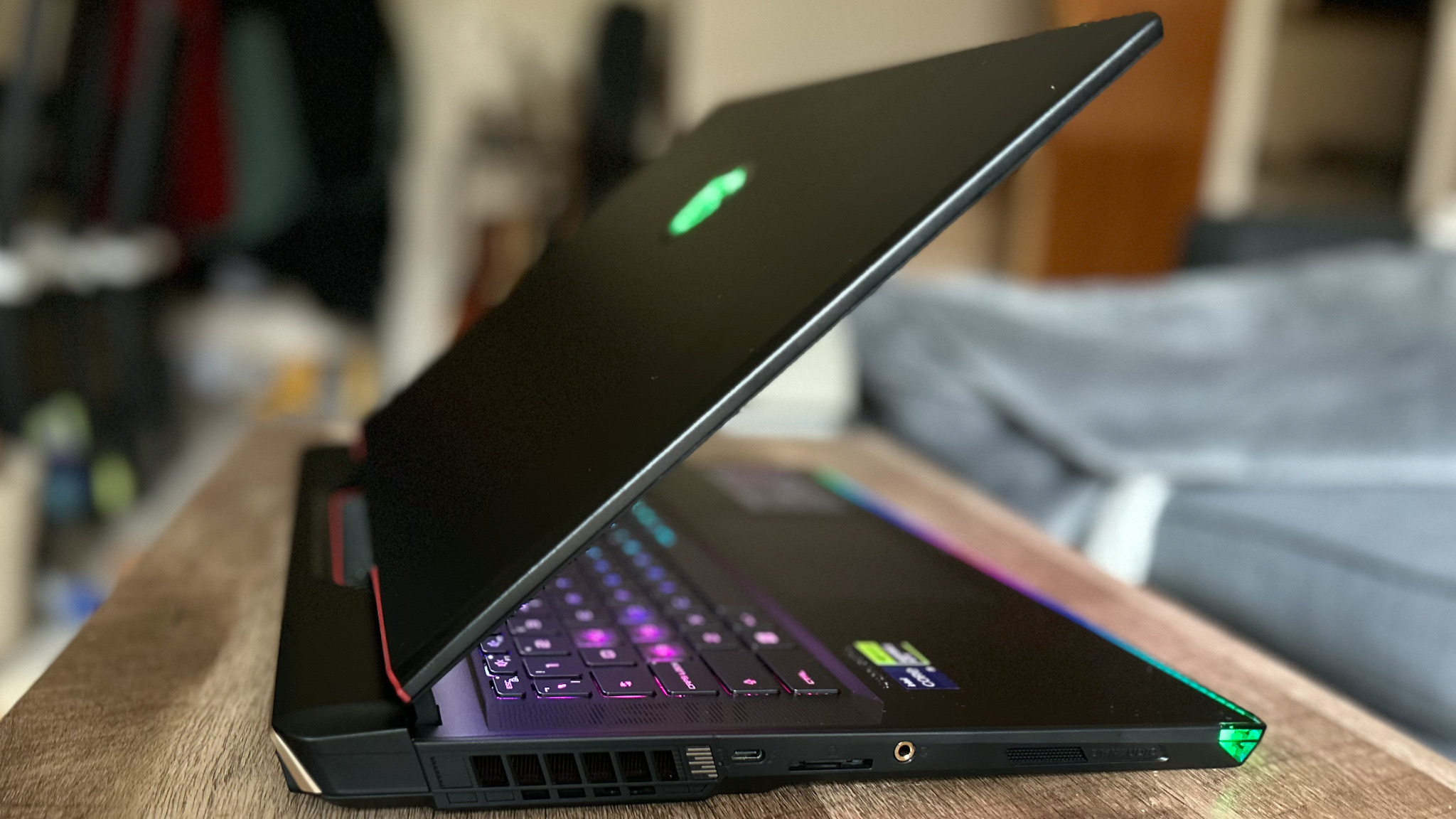GamesRadar+ Verdict
The MSI Raider GE78 feels a little stuck in the past, despite offering the widest range of new generation components we've tested so far. However, a dated form factor and aesthetic and lack of 2023-esque features like MiniLED displays and G-Sync mean the excellent performance is overshadowed by better all-round value for money elsewhere.
Pros
- +
Fantastic performance overall
- +
Ports and connectivity are excellent
- +
Ethernet connection available
- +
Sturdy build quality
- +
Wide range of RGB options
- +
Full keyboard with number pad
Cons
- -
Older cooling system can hold performance back
- -
Other machines can offer more features for the same price
- -
Unwieldy form factor
- -
Slightly dated aesthetic
- -
No G-Sync
Why you can trust GamesRadar+
The MSI Raider series has always sat in the Titan's shadow, and while it's still on the second rung of the ladder in 2023's lineup, there's some serious grunt to take note of. Sporting the latest and greatest Intel 13th generation processors and the upper echelons of Nvidia's RTX 40-Series graphics cards, this isn't a cheap machine. However, if you're after raw power in a unique chassis design it could be worth investing.
This year we've got a full redesign of the GE78 model, with a revisited light bar and a deeper 16:10 form factor to contend with. Not all these changes are particularly welcome - and many actively go against the grain of the industry's progression - but they do prove their worth for the right kind of player. I used the 2023 MSI Raider GE78 HX 13V with an RTX 4080 GPU and Intel i9-13950HX processor for three weeks, to see just where it sits among the best gaming laptops of the year so far.
| Spec | Tested | Also Available |
|---|---|---|
| Price | $3,599 / £3,279 | $3,599 - $3,749 / £2,499 - £3,799 |
| Display | 17-inch IPS at 16:10, 2560 x 1600, 240Hz | 17-inch IPS at 16:10, 1920 x 1200, 165Hz |
| Processor | Intel Core i9-13950HX | Intel i9-13980HX, Intel i7-13700HX |
| GPU | Nvidia RTX 4080 | Nvidia RTX 4090, Nvidia RTX 4070 |
| RAM | 32GB DDR5 | 16GB, 64GB |
| Storage | 2TB SSD | Up to 8TB |
| Connectivity | WiFi 6E, Bluetooth 5.2 | - |
| Ports | 1x USB-A 3.1 Gen 1, 1x USB-A 3.2 Gen 2, 1x USB-C 3.2 (Thunderbolt 4), 1x USB-C Gen 2 (Display Port & Power Delivery), 1x USB-C Gen 2 (Display Port), 1x HDMI 2.1, 1x SD card reader, 3.5mm, 1x 2.5G Ethernet | - |
| Dimensions | 380mm x 298mm x 23mm | - |
| Weight | 3kg | - |
Design
- Narrow but deep design is unwieldy
- Excellent build quality with no flexing concerns
- Dated form factor and aesthetic
The design is where the MSI Raider GE78 first bucks the trends of the day. Rather than swimming along with the 18-inch and 16-inch models hitting the shelves right now, the 2023 Raider holds firm to its 17-inch form factor. You're still picking up a 16:10 aspect ratio, though, which makes for a blocky machine with a narrow but deep footprint. That makes transport a little difficult, most laptop backpacks have been designed with a 16:9 form factor in mind, even in the larger sizes. That, plus the enormous charging brick and heavy design mean this isn't one to take on the road.
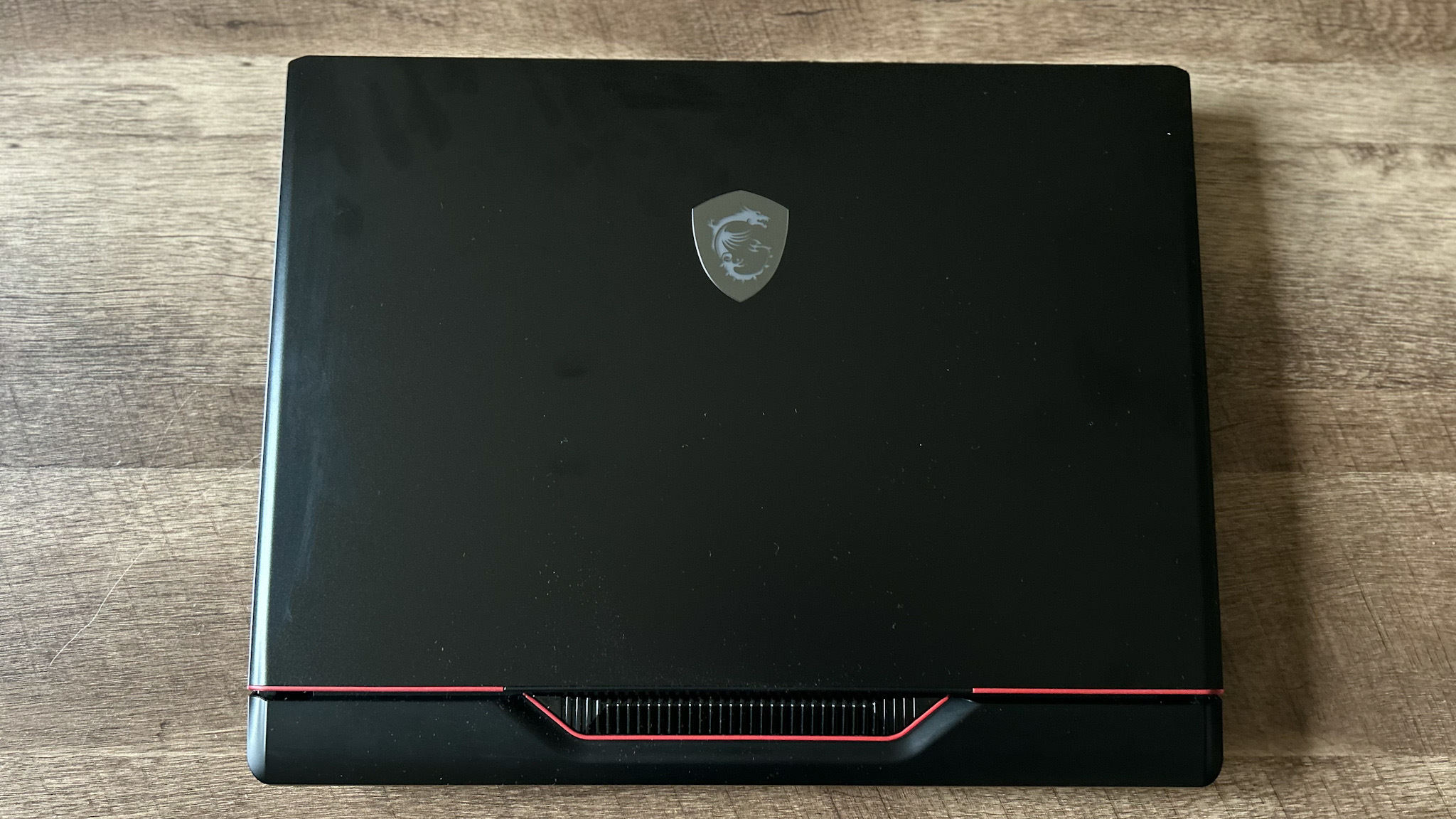
This design does feel a little dated. After all, 18-inch machines don't take up that much space these days thanks to efficient designs balancing as much screen as possible while keeping the chassis small. With a smaller screen but about the same bulk as the majority of 18-inchers on the market, it's difficult to compliment the footprint as a whole. On top of that, MSI is still using the angular lines and red stripes that have adorned its machines since time began. For that reason, it doesn't quite look like the premium 2023 gaming laptop at this price point.
That extra heft is largely due to the additional space at the back of the machine behind the display. This extra wedge carries IO ports and houses cooling tech. While that does mean you're getting space for upward-firing speakers through the main deck, and you can keep power, display, and Ethernet cables out of view, I would have preferred a more conventional form factor for everyday use here.
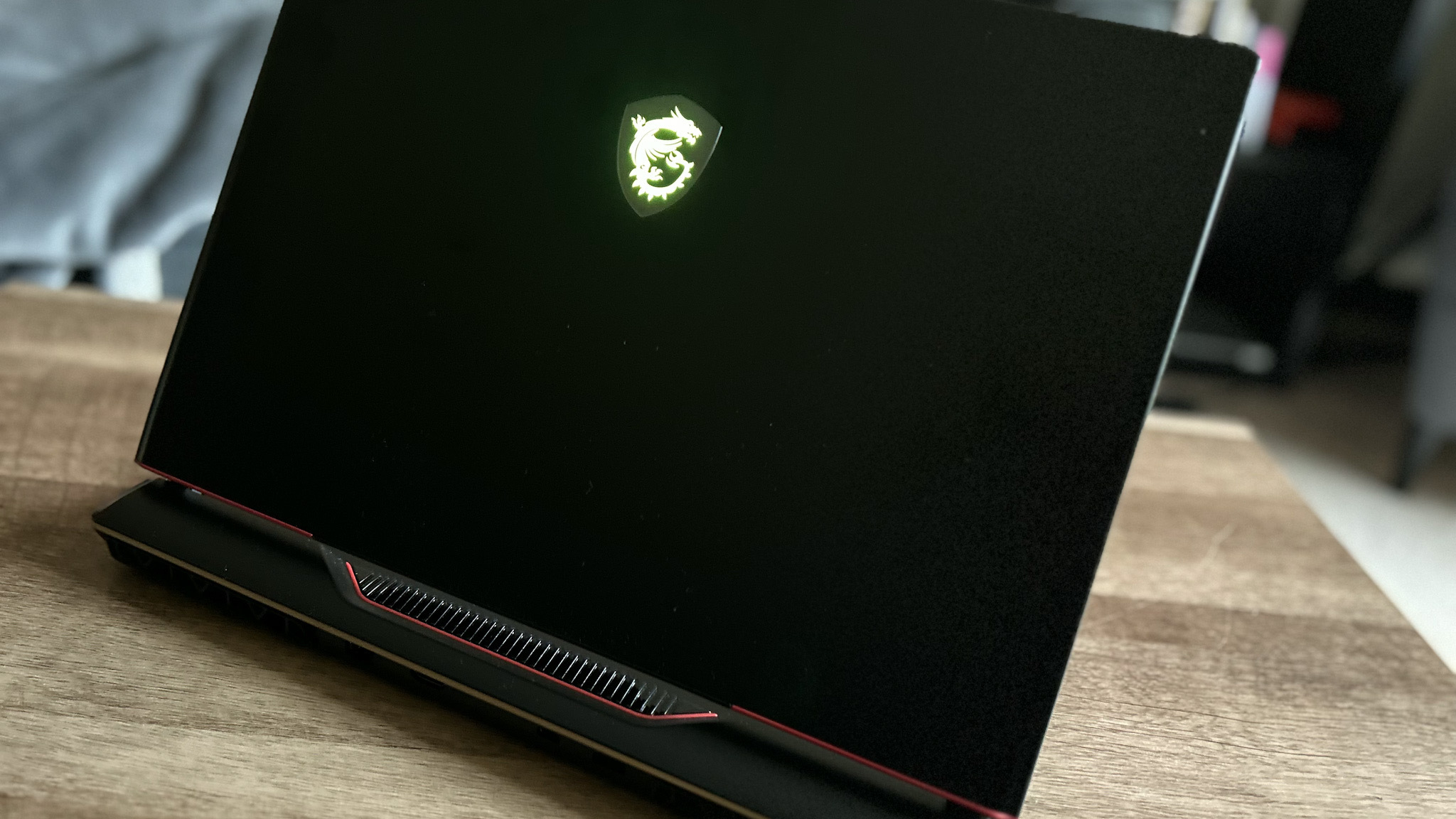
That said, everything is put together well. The metal chassis stands firm with no creaks or flexing across the main deck. The display, and its hinges, feel solid and secure in one-handed operation with very little wobble. This is an exceedingly well-built machine - an upside to a particularly stocky nature.
As one would expect from a Raider machine, there's plenty of RGB to go around as well. The most attention-demanding is the giant lightbar splashed across the front edge. Rather than opting for a smoother, more blended array of LEDs like in previous iterations, though, MSI has turned back the clock offering an almost pixelated design. It's a neat aesthetic flourish that sets the GE78 apart from the rest of the lineup and doesn't get in the way of on-screen action or off-screen concentration. Of course, it can always be switched off if you prefer to take a stealthier approach.
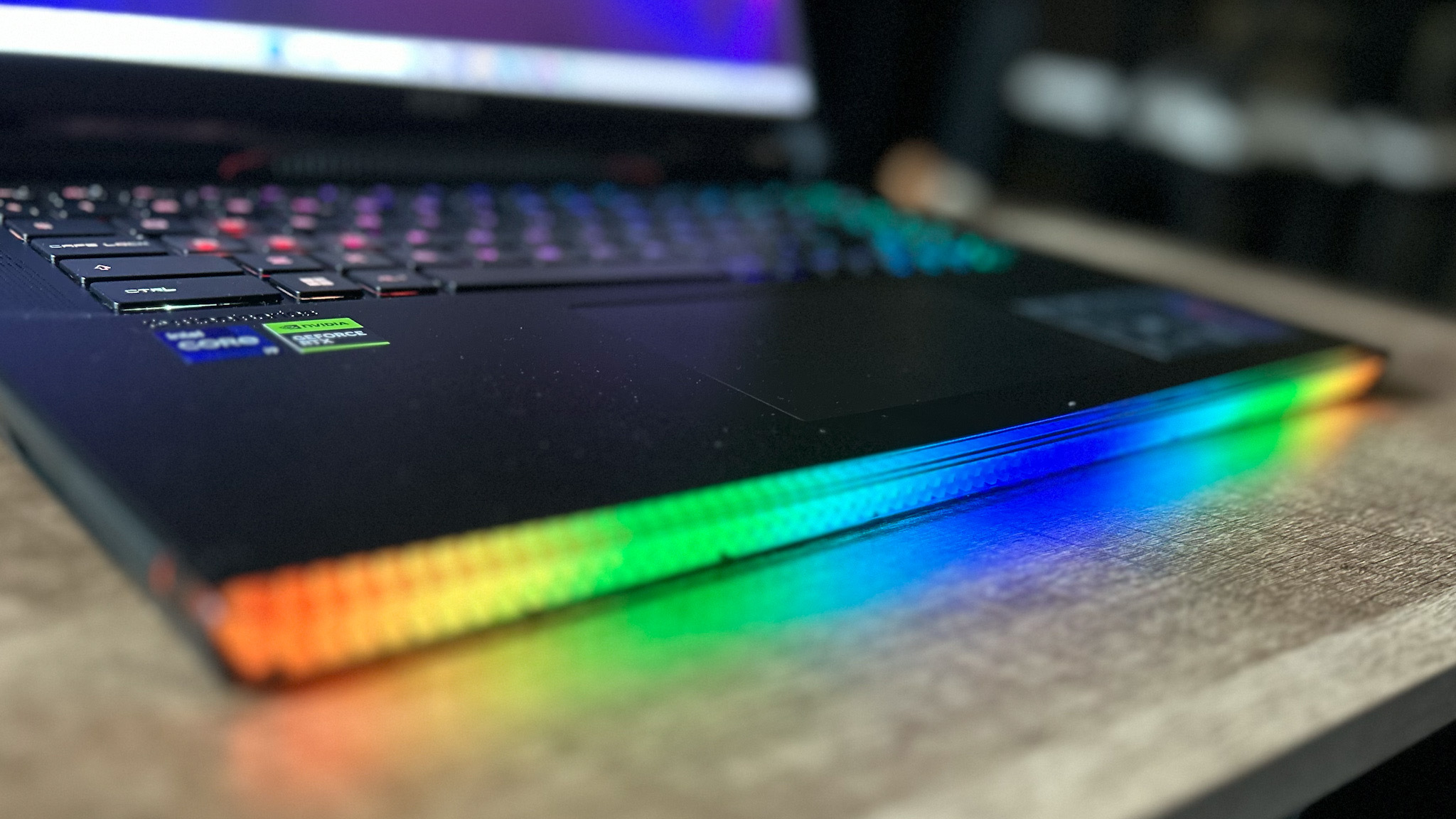
Either way, this front lip is particularly enjoyable to rest on. The smooth curved design keeps things easy on the palms, though the main base is so large I rarely found myself taking advantage of it.
Features
- Nice range of components available at launch
- Cooling system isn't sufficient for high-end configurations
- IPS display with no G-Sync can't keep up with others at this price
That larger chassis is certainly holding everything you would expect it to. Under the hood, configurations span RTX 4070 - RTX 4090 GPUs with three Intel processors to choose from; the i7-13700, i9-13950HX, and i9-13980HX. You can pack in up to 64GB DDR5 RAM and cram SSDs totaling up to 8TB of storage space as well. Of course, these higher-tier models are going to cost you considerably, but if you're after an all-in-one powerhouse the Raider's selection of components will have you covered. This is all top-of-the-range stuff, as is to be expected from a major flagship release. For reference, the Asus ROG Zephyrus M16 taps out at an Intel i9-13900H at the moment, and the Asus ROG Strix Scar 16 only offers a high-end Intel i9-13980HX CPU with either an RTX 4080 or RTX 4090, so you've got plenty more options at launch here.
Taking full advantage of all that goodness does come with some sacrifices, namely to the ears. To keep up with the increased thermal demands of this new generation tech, many gaming laptops are upgrading their cooling systems to include more sophisticated vapour chambers and liquid/gel options. MSI has stuck with a more traditional cooling system, relying on heat pipes and two fans to try and keep its insides from melting.

Unfortunately, this system doesn't quite work. I noticed performance drops when temperatures did start to climb (and they climbed fast), and the fans required to keep everything running were the loudest I've ever tested. I did find some reprieve in propping the back of the machine up slightly on the desk (the small rubber feet underneath do very little to encourage airflow by themselves).
If USB-C is your game, though, you're going to be one happy player. The MSI Raider GE78 sports three USB-C ports, though each one seems to carry its own caveat. The main USB-C on the rear of the device can connect via DisplayPort with a direct line to the Nvidia GPU, and another on the left-hand side packs Thunderbolt 4 with DisplayPort to the integrated graphics chip. The third doubles up on your dedicated GPU DisplayPort options, but also claims to offer power delivery. This is fine for everyday use, and closed lid charging (once settings have been tweaked), but I just couldn't draw enough power to keep the Raider running off this port alone in-game, no matter what title it was.
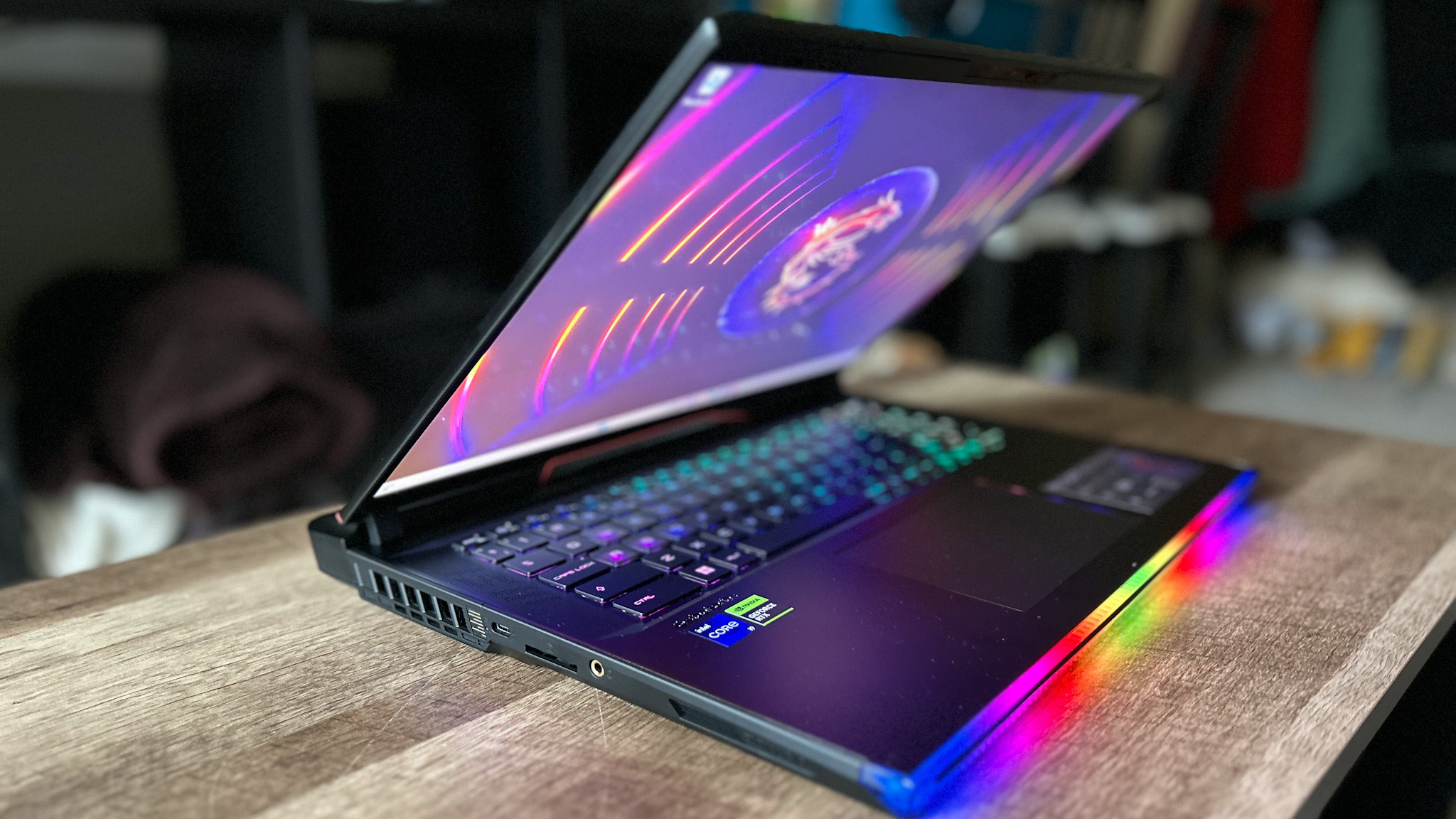
Elsewhere you've got an HDMI 2.1 capable of outputting 8K resolution at 60Hz or 4K resolution at 120Hz, a micro-SD card reader, a 3.5mm audio jack, and an incredibly rare Ethernet port as well. That's pretty much everything one could ask for in a high-end machine, and you'll be well served by the connections on offer.
The main base carries a full-sized keyboard including a skinny num-pad to the right. Everything here is well-spaced, though the keys are a little more shallow than you'll find on other machines. It's not a bad typing experience, but just one that sits more in line with an everyday chiclet deck rather than the more satisfying, tactile keys we've grown used to in the gaming space.
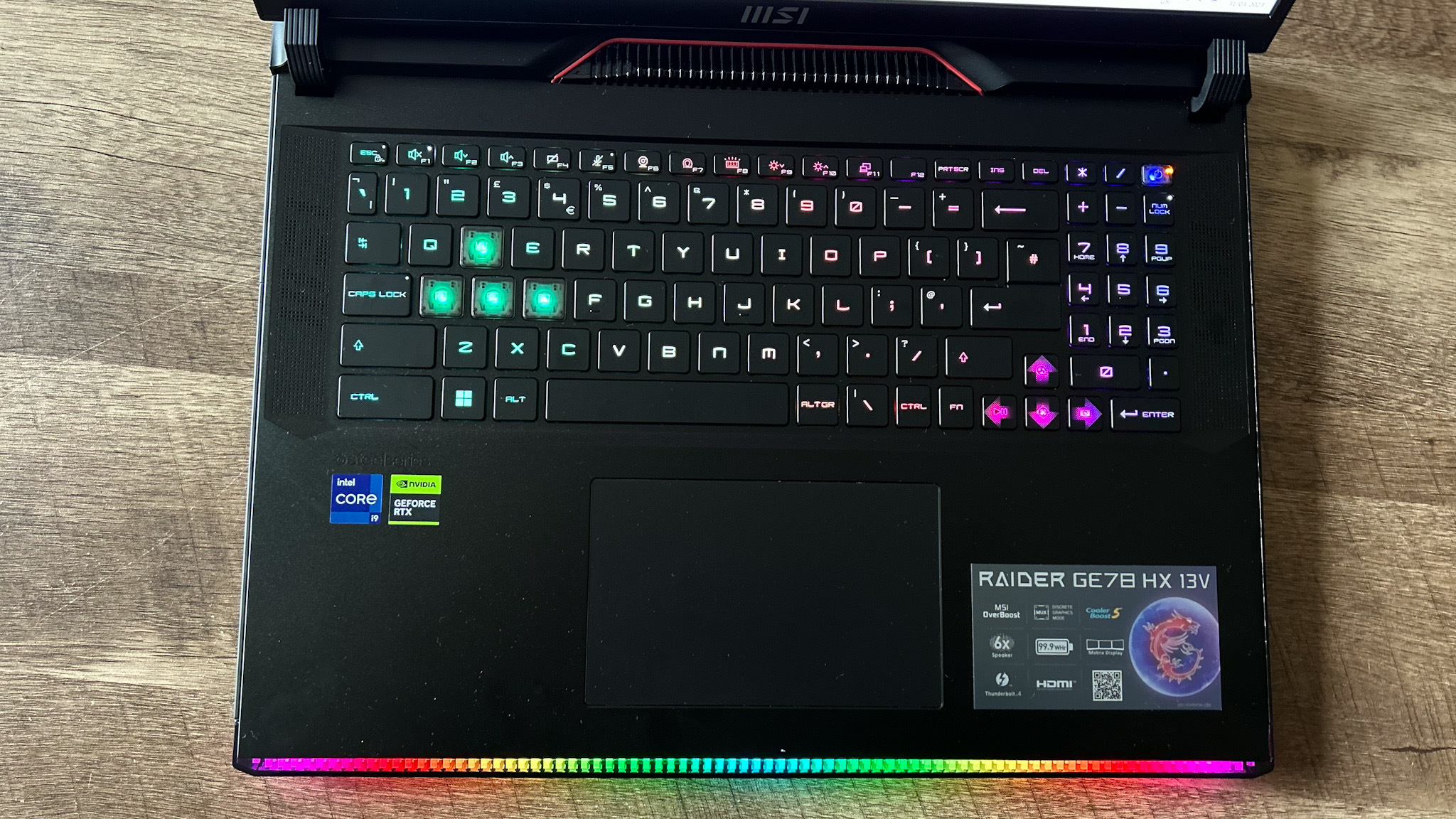
I've also never been a massive fan of the legend font on MSI's laptop keyboards. It's a small gripe, but the curved letters always looked a little cheap and they're back here on a particularly expensive machine. Keycaps are comfortable and smooth, with transparent caps on WASD and the slightly-too-small arrow keys allowing those RGB LEDs to shine through.
The trackpad is a good size, perfect for wider sweeps to traverse the full screen with precision. However, the material felt a little sticky in my testing, with too much resistance to truly feel like a smooth glide.

Contrary to many high-end machines, the MSI Raider settles for an IPS display. That would have been fine last year, but 2023 has brought about the widespread adoption of MiniLED screens in more of these $3K+ rigs. Having spent the last month or so checking out two machines offering this tech, I did miss the extra clarity and crispness. However, the Raider's screen still performs admirably with vivid, punchy colors and a nice warm tone.
There are yet more sacrifices with this screen, though. MSI doesn't offer G-Sync on any of its machines, which means you're playing with a classic MUX system here. That's disappointing in this price range and, while that 240Hz refresh rate is certainly working hard for you - everything feels snappy and responsive - it may not fare as well further down the line.
Performance
- Incredible framerate results...
- ... which suffered after temperatures rose
- Beat previously tested Asus laptops in this price range
For all its outdated design choices and sacrifices, the MSI Raider GE78 certainly shows up when it comes to raw performance. Posting numbers that beat both the Asus ROG Zephyrus M16 and Asus ROG Strix Scar 16, the Raider is out in front right now. This is the most effective pairing of an Intel 13th generation i9 processor with an Nvidia RTX 40-Series graphics card I've tested so far, offering some incredible results. The below figures were achieved using the highest possible performance settings on each machine (Extreme in the case of the Raider).
| Benchmark | MSI Raider GE78 (RTX 4080) | Asus ROG Zephyrus M16 (RTX 4090) | Asus ROG Strix Scar 16 |
|---|---|---|---|
| Timespy | 18,658 | 14,608 | 17,611 |
| Fire Strike | 33,297 | 31,877 | 32,876 |
In-game tests were impressive as well. Native QHD+ performance was certainly an eye-opener, though it should be noted that the excellent results below were captured at the start of each session. Once things began heating up, framerates certainly suffered. There's some serious potential in this implementation of new generation components, but unfortunately, the insufficient cooling does rear its ugly head. Aside from the extreme noise created by those fans, using the laptop on a desk by itself started to drop those numbers at around the 20-minute mark.
PC Mark 10: 7,931
Cinebench: 28,491
Crystal Disk Mark: 7,014MB/s read, 5,199MB/s write
For example, when averaging 150 - 165 fps in Shadow of the Tomb Raider at the start of a session that regularly dropped to around 120 or even sometimes 110. Of course, that's still three figures - numbers any high-end gaming laptop would have satisfied itself with just a couple of years ago. However, Shadow of the Tomb Raider is a particularly easy game to run well, I was dropping further into the two-figure territory on more demanding titles like Total War: Three Kingdoms and in everyday Cyberpunk 2077 sessions. Even with Cooler Boost enabled I wasn't seeing any performance improvements.
| Benchmark | Native 2560 x 1600 |
|---|---|
| Shadow of the Tomb Raider | High: 158fps / Highest: 149fps |
| Total War: Three Kingdoms | High: 141fps / Ultra: 92fps |
| Metro Exodus | High: 129fps / Ultra: 106fps |
| Red Dead Redemption 2 | Balanced: 124fps / Top: 115fps |
| The Division 2 | High: 146fps / Ultra: 129fps |
While initially an impressive rig, then, there are sacrifices to be made in the Raider's overall performance. An extra cooling pad or laptop raiser certainly helps, though, and should be considered a must-have accessory if you're being swayed by those heady early numbers.
Should you buy the MSI Raider GE78?

The MSI Raider GE78 is a gaming laptop fraught with contradictions and buts. You've got an excellent spread of high-end and mid-range components that work in perfect harmony with one another to produce some fantastic results - but the thermal regulation just can't keep up with them. You've got a sturdy, solid form factor with plenty of space, but a footprint that sits awkwardly and has a dated aesthetic. You've got a speedy, responsive 16:10 screen, but one that drops G-Sync and the more premium MiniLED panels other laptops are shipping with these days.
The 2023 MSI Raider is going to be the perfect fit for a very small number of players. If you've known and loved MSI's gaming laptops for a long time and you're keen to update with some new generation components, it's a solid bet - just be sure to grab some extra cooling accessories. However, if you're looking to invest in long-lasting, reliable performance there is better value for money available elsewhere.
How we tested the MSI Raider GE78
I used the MSI Raider GE78 for three weeks, running all work, play, streaming, and everyday browsing tasks through the rig during that time. I primarily tested across Shadow of the Tomb Raider, Metro Exodus, Cyberpunk 2077, Sable, Borderlands: The Presequel and Planet Coaster before stress testing using in-game benchmark tools. I also used PC Mark 10, Cinebench, and Crystal Disk Mark 10 for more industry-standard testing tools. To find out more about how we test gaming laptops, check out the full GamesRadar+ Hardware Policy.
We're also rounding up all the best Alienware laptops, the best Razer laptops, and the best Asus gaming laptops if you're looking to browse by brand. Or, take a look at the best gaming PCs for something a little more permanent.

Managing Editor of Hardware at GamesRadar+, I originally landed in hardware at our sister site TechRadar before moving over to GamesRadar. In between, I've written for Tom’s Guide, Wireframe, The Indie Game Website and That Video Game Blog, covering everything from the PS5 launch to the Apple Pencil. Now, i'm focused on Nintendo Switch, gaming laptops (and the keyboards, headsets and mice that come with them), PS5, and trying to find the perfect projector.
